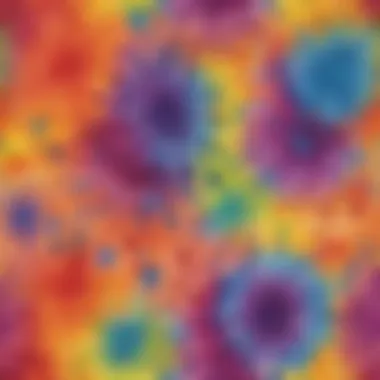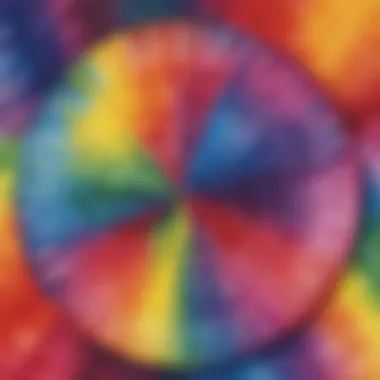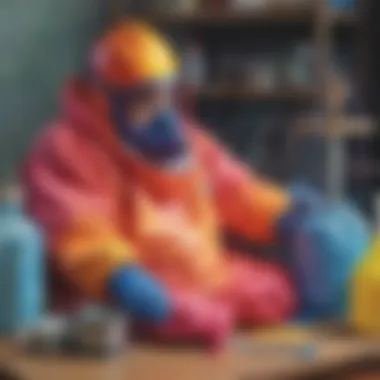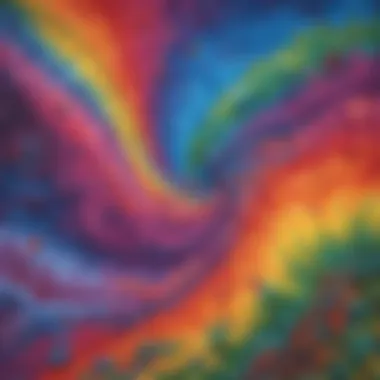Understanding Tie Dye Chemicals and Their Impact


Intro
Tie dye has become a staple of creative expression, often seen splashed across clothing and home decor. But behind the vibrant hues and whimsical patterns lies a world filled with fascinating chemistry. This section will take you on a journey, unraveling the science that allows us to transform plain fabrics into colorful works of art.
We’ll explore the key compounds used in tie dye, the process of how colors are formed, safety considerations for young artists, and importantly, the environmental impacts of dyeing practices. For the curious minds out there—whether you’re a child eager to learn or a parent guiding this adventure—the science of tie dye blends creativity with crucial chemical principles.
Science Fun Facts
- Color In Nature: Did you know that natural dyes can come from everyday kitchen ingredients? Turmeric for a sunny yellow, red cabbage for a purple hue, and coffee for a rich brown.
- Age of Dyeing: The art of dyeing fabrics dates back thousands of years, with some of the earliest evidence found in Peru, where people dyed cotton with plant dyes over 3,000 years ago.
- Chemical Reactions: When dye is added to fabric and heat is applied, a chemical reaction occurs. This helps the dye bond with the fabric fibers, resulting in long-lasting color.
"In tie dye, every swirl and spiral tells a story of science and artistry meeting hand-in-hand."
Interesting Trivia and Facts
- Dye Types: There are two main types of dyes—direct and reactive. Direct dyes can be applied easily and bond without a chemical reaction. Reactive dyes, however, create a stronger bond with fibers through chemical reactions, which is essential for vibrant results.
- Color Wheel Fun: The color combinations that emerge from tie dye relate to the principles of color theory. Mixing warm and cool colors can create entirely different feelings and visual impacts.
- Historical Uses: Ancient civilizations used tie dye in everything from ceramics to clothing for ceremonial purposes, linking colors to spirituality and culture.
Quirky Science Stories
Imagine a group of scientists vying to create the most vibrant, eye-catching dyes. One such team experimented with unusual ingredients like beet juice and even crushed flowers. These unconventional choices resulted in mind-boggling colors, demonstrating that creativity doesn’t end at the palette.
Amazing Science Records
- Largest Tie Dye: The largest tie-dye ever made was a staggering 7,020 square feet in size! It was made in 2009 in New York City and took numerous hands to achieve such a colorful feat.
- Fastest Dyeing: Some emerging techniques using technology claim to dye fabrics in under thirty seconds, revolutionizing traditional dyeing processes.
Thought-Provoking Questions
- How do different fabric types affect dye absorption?
- What role do natural versus synthetic dyes play in our environment?
As we continue this exploration into the chemistry of tie dye, bear in mind that what appears to be merely a playful activity is grounded in the very principles of science. Let's dive deeper into color formation and ensure our artistic endeavors are both fun and safe.
Foreword to Tie Dye Chemicals
The colorful realm of tie dye might appear to be just a creative expression, but there’s a surprising depth underneath the swirl of colors that deserves attention. Understanding tie dye chemicals can open doors to insights about not just this art form, but also the scientific principles that govern color and material interactions. This section provides a foundational understanding of why tie dye chemicals hold significance, going beyond aesthetics.
The Art of Tie Dye
Tie dyeing is an age-old practice that combines art with science, and it has cultural heritage in various parts of the world. Whether it's the intricate patterns of the Japanese Shibori or the vibrant colors of the classic hippie style, tie dye reflects a blend of creativity and natural beauty. However, at its core, tie dyeing is also about chemistry.
When a designer twists and folds fabric, they create spaces that react uniquely to the application of dyes. These dyes don’t just splash onto the areas; instead, they chemically bond with the fibers in the fabric. Two types of classification commonly used are synthetic dyes, often derived from petroleum products, and the more eco-conscious natural dyes made from plants and minerals.
Understanding the processes involved in tie dye isn't just for artists; educators can use them as excellent teaching moments about chemical reactions, molecular interactions, and the role of specific chemicals. It's not just tie dye; it's a tool for discovery.
Why Chemicals Matter
The chemistry behind tie dye is crucial for a variety of reasons. Firstly, it dictates the intensity and longevity of colors, which are tied to the choice of dye and how well it binds with the fabric. The right chemical agents can transform a plain piece of cloth into a striking piece of art. Without the right understanding, one might end up with colors that fade faster than they can be appreciated.
Furthermore, chemicals impact the safety and environmental aspects of tie dye. The materials used, including mordants and fixatives, can either be friendly to our ecosystems or detrimental. For instance, iron is a common mordant that enhances dye intensity, but it also raises concerns regarding rust and pollution.
In sum, knowing about tie dye chemicals provides valuable insight into the relationship between art and science, instilling essential knowledge that can guide future creators towards safer, more sustainable practices. The journey into exploring this fascinating intersection holds promise and potential for curious minds.


Types of Tie Dye Chemicals
Understanding the various types of tie dye chemicals is crucial for anyone interested in practicing this vibrant art form. These chemicals not only play a vital role in the dyeing process, but they also influence the quality, longevity, and vibrancy of the colors you can achieve. By delving into what each type offers, artists can make informed choices about their supplies, leading to more successful and satisfying results.
Dyeing Agents
Dyeing agents are the heart and soul of tie dye. They are the substances responsible for imparting color to the fabric. Essentially, these agents can be divided into two main categories: Synthetic Dyes and Natural Dyes.
Synthetic Dyes
Synthetic dyes have become a staple in the dyeing world due to their versatility and range of colors. These dyes are engineered in labs, allowing for consistent results and vibrant hues. One key characteristic of synthetic dyes is their ability to bond well with various fabrics, ensuring colors remain bright even after multiple washes. This makes them a popular choice among tie dye enthusiasts.
However, while synthetic dyes often promise rich color payoff, there are some considerations. They might contain harmful chemicals that can be an irritation to skin if proper handling isn't observed. There are also environmental concerns about how these dyes are produced and disposed of.
Natural Dyes
Natural dyes, on the other hand, derive their pigment from plants, minerals, or even insects, making them an environmentally friendly option. One of their standout features is the unique, often unpredictable colors they produce, which can give tie dye a distinct and whimsical appearance. This addition brings a soulful connection to traditional practices and a deeper appreciation for the art.
Yet, the process can be a bit more labor-intensive compared to synthetic dyes, as extracting color from natural sources may require extra steps. Additionally, the colors might fade over time, especially if the dyed fabric enjoys a bit too much sunshine.
Mordants
Mordants are another essential component in tie dyeing, acting as intermediary agents that bind dyes to the fabric. Their use can significantly enhance the vibrancy and permanence of colors applied to fibers.
Role of Mordants
The primary function of mordants is to create strong bonds between the dye molecules and the fabric fibers. This ensures that the colors stick around for the long haul. One key characteristic of mordants is that they can alter the final color of the dye, sometimes producing surprising results. This versatility makes them a favorite for creating custom designs and shades.
However, it's essential for artists to be aware that some mordants can be toxic, which raises safety concerns during use. The choice of mordant can also affect fabric texture, requiring a bit of experimentation to achieve the desired outcome.
Common Mordants Used
When it comes to common mordants, alum is one of the most frequently used options, known for its safety and effectiveness. It increases color fastness in many dye situations. Other mordants like ferrous sulfate and copper sulfate can create unique effects but demand careful handling due to their potentially hazardous nature.
Exploring the world of Mordants opens a pathway to understanding how subtle changes can drastically shift outcomes in any tie dye project.
Fixatives
Lastly, there are fixatives, which play a pivotal role in securing the applied dyes once the dyeing process is complete. They lock in colors and enhance the durability of the finished product.
Purpose and Importance
The purpose of using fixatives is straightforward: to prevent the dye from washing out or fading away. This aspect is crucial for anyone who wants their artwork to last. An important feature of these chemicals is they can improve wash-fastness—essentially how well the fabric retains its color after cleaning.
Depending on the specific fixative used, the final appearance may also differ, offering artisans a broader palette of possibilities for their creations.
Types of Fixatives
There are different types of fixatives available, ranging from chemical fixes to more natural options. For instance, soda ash is a common choice among tie dyers as it not only helps in fixing colors but can also enhance brightness. On the flip side, natural fixatives might come from sources like salt or vinegar, offering an eco-friendly approach.


Each category of fixatives brings its own benefits and limits, allowing for a spectrum of artistic choices in the intricate world of tie dye.
Chemical Reactions in Tie Dye
Chemical reactions play a central role in the world of tie dye, where the interaction between dyes and fabrics brings forth vibrant designs and color transformations. Understanding these reactions not only allows artists to create stunning visuals but also equips them with the knowledge to manipulate outcomes. By grasping the chemistry behind how dyes bond to fabrics and the mechanisms that dictate color development, a deeper appreciation of the art form emerges.
How Dyes Bond with Fabric
The bonding process between dyes and fabrics is a fascinating interplay that hinges on molecular forces. When a fabric is introduced to a dye, different types of interactions take place. The most common bonding mechanism is called adsorption, where dye molecules adhere to the surface of the fabric fibers. Think of it like attracting a magnet; the textile's structure and the chemical nature of the dye determine how well they stick together.
In tie dye, this process is influenced by:
- Fiber composition: Natural fibers like cotton or silk absorb dyes differently than synthetic materials such as polyester. The chemical properties of these fibers make them more or less compatible with specific dyes.
- Mordants used: Mordants help fix the dye to the fabric, making it more durable. They create a bridge between the dye and the fabric fibers, ensuring that colors stay vibrant.
Overall, the bonding of dyes to fabric is not just a random chance; it’s a symphony of chemical interactions. Knowing how these bonds form helps artists achieve the desired effects more consistently.
Color Development Mechanisms
Color in tie dye arises through a variety of chemical processes that can be rather complex. The behavior of dyes when exposed to various conditions directly impacts the final shade and intensity of color. Key processes include:
- Chemical transformation: Many synthetic dyes undergo changes when exposed to heat or specific pH levels, leading to different colors appearing. For example, a dye could look blue under normal conditions but turn to purple if heat is applied.
- Lightfastness: This refers to how well a color resists fading when exposed to sunlight. Some dyes have inherent properties that make them more stable, while others require extra treatments to stay vibrant over time.
- Dilution and concentration: The amount of dye used during the tie dye process can drastically change the resulting colors. A concentrated application might yield a deep, intense color, while a diluted one could create softer pastels.
Understanding these color development mechanisms empowers artists by enabling them to predict and manipulate the outcomes more effectively.
By grasping the link between chemical reactions and tie dye, artists can enhance their craft, leading to more innovative designs and sustainable practices. The excitement of seeing color come to life through science can capture the imagination of young artists, and the journey of experimentation can be just as rewarding as the final result.
Safety Considerations
When delving into the vibrant world of tie dye, safety remains paramount. Working with chemicals—whether they’re dyes, mordants, or fixatives—poses potential hazards. It’s essential to understand both the risks involved and the measures to mitigate them. Engaging in tie dye can be a thrilling exploration of creativity, but without proper safety measures, the process can turn into a slippery slope. This section highlights crucial aspects of handling chemicals safely and the protective gear required to keep it all, quite literally, colorful rather than hazardous.
Handling Chemicals Safely
Safety begins long before the dye hits the fabric. The first step in handling chemicals safely is being aware of the materials used during the tie dye process.
- Read Labels Diligently: Every chemical product comes with instructions—those warnings aren’t just for show. It’s vital to read these labels thoroughly. They provide information about potential hazards and instructions for safe use.
- Work in Well-Ventilated Areas: Strong odors might seem like part of the fun, but exposure to chemical fumes can lead to headaches or worse. Always work in spaces with ample air circulation. Open windows or use fans to keep fresh air flowing.
- Avoid Mixing Chemicals: Just because two substances are available doesn't mean they’re meant to be combined. Many chemicals can react in unexpected and dangerous ways when mixed. Stick to following the instructions without improvisation.
- Proper Storage: Keep chemicals in their original containers with their labels intact. Ensure they are stored in a locked cabinet, away from children and pets, to minimize any risk of accidental exposure.
By adhering to these guidelines, anyone taking part in tie dye can ensure a much safer experience that focuses on creativity rather than danger.
Protective Gear Essentials
Equiping yourself with the right protective gear is like putting on armor before a battle. These items not only safeguard against irritation but also translate to a smoother, worry-free dyeing process.
- Gloves: Latex or nitrile gloves protect your hands from skin contact with dyes and chemicals. Not only do they prevent stains, but they also keep your skin from potential allergic reactions.
- Goggles: Protection for your eyes is no small matter. Goggles can shield your eyes from splashes and fumes, preserving your vision and comfort throughout the process.
- Aprons or Old Clothing: Wearing an old shirt or apron is a smart move. Avoid your favorite clothes from being transformed into a tie-dyed puzzle; dyes can be stubborn.
- Face Masks: If the chemicals have a strong odor, a face mask can help filter out fumes. This becomes particularly important in spaces with insufficient ventilation.
"Safety is not just a priority; it’s the foundation upon which creativity builds its colorful expressions."
In summary, keeping safety in the forefront is vital while working with tie dye chemicals. By following proper handling techniques and donning protective gear, the adventure of tie dye can be enjoyed with peace of mind.
Environmental Impact of Tie Dye Chemicals


In today's world, understanding the environmental impact of tie dye chemicals is vital for both artists and consumers alike. As people increasingly aim to combine creativity with sustainability, the quest for eco-friendliness has taken center stage. This section will explore how the chemicals involved in tie dye processes can affect our environment, the importance of using biodegradable dyes, and viable eco-friendly alternatives.
Biodegradability of Dyes
Biodegradable dyes are like a breath of fresh air in the dyeing process. Traditional synthetic dyes often end up polluting waterways when they’re washed off from fabrics, impacting aquatic life and ecosystems significantly. These dyes don’t break down easily, so they can linger in the environment, acting like stubborn houseguests who simply refuse to leave.
In contrast, biodegradable dyes are designed to decompose naturally over time. This means they don't just sit around in waterways or soils causing havoc. For instance, natural dyes derived from plants, fruits, and vegetables often fall into this category, making them a safer option. Think of turmeric or beet juice; not only do they add vibrant hues, but they also leave behind a smaller ecological footprint.
"Opting for biodegradable dyes is akin to choosing a path less traveled, one that not only beautifies fabric but also sustains the planet."
When artists and hobbyists choose biodegradable options, they not only enhance their artworks but also foster a healthier relationship with nature. It’s a win-win situation where creativity meets responsibility.
Eco-Friendly Alternatives
The journey towards eco-friendly tie dye practices doesn’t stop at choosing biodegradable dyes. There's a treasure trove of alternatives that can make a real difference. Here are some other effective methods:
- Plant-Based Dyes: These are originating from sources like indigo, which is harvested from plants. Using plants for dyeing is in many ways akin to tapping into nature's color palette.
- Recycled Materials: Elements like shredded paper or leftover food scrapes can serve as natural dye sources or aids in the dyeing process. It’s like giving trash a second life.
- Non-Toxic Fixatives: Instead of harsh chemical fixatives, using options like vinegar or salt can effectively set the dye without laying a thick layer of pollution on the environment.
- Water Management Techniques: Incorporating water-efficient techniques during the dyeing process can help mitigate the impact. For instance, rinsing fabric with minimal water use when setting dyes can conserve resources and reduce chemical runoff.
Moving towards these eco-friendly practices doesn’t mean sacrificing quality or color. In fact, it can lead to more unique, vibrant results that reflect a commitment to environmental stewardship. As each artist embraces these alternatives, they play a part in steering the tide toward a more sustainable future for tie dye.
In summary, the environmental impact of tie dye chemicals holds significant weight. By choosing biodegradable dyes and alternatives, the art of tie dye can flourish while being considerate to the planet.
The Future of Tie Dye Chemicals
The world of tie dye chemicals is on the brink of transformation. As we continue to harness our understanding of chemistry, the future beckons with endless possibilities. The advancements in dye technology not only promise brighter, more vibrant colors but also aim to lessen the environmental footprint that traditional dyeing methods often leave behind. By embracing innovation and sustainability, we pave the way for a new era of creative expression, blending art and science seamlessly.
Innovations in Dye Chemistry
Innovations in dye chemistry are creating waves in the textile industry, reshaping how we think about colors and pigments. For starters, researchers are developing biobased synthetic dyes that offer strong colorfastness while being derived from renewable resources. Instead of petroleum-based products, which are common in traditional dyes, these new dyes might come from plants or even waste materials.
Another intriguing area of development involves smart dyes that change color in response to environmental conditions. Imagine fabrics that shift colors based on temperature or light exposure! Such technology not only spawns artistic possibilities but might also have practical applications in fashion, where a single garment can serve multiple purposes or moods.
"The intersection of nature and technology presents opportunities we have yet to fully explore."
Additionally, microbial pigments are gaining traction. Bacteria can produce stunning colors naturally, bringing nature’s palette straight to the fabric. These microbes can be cultivated in controlled environments, providing a more sustainable and safe alternative to conventional dyeing methods, which often involve harsh chemicals. A growing interest also highlights the importance of non-toxic dyes, ensuring safety for both makers and consumers.
Sustainable Practices
As awareness about the impact of chemical usage in tie dye grows, sustainable practices are becoming paramount. Conversation around adopting closed-loop systems in dye production is on the rise. This method recycles water and chemicals within the dyeing process, significantly reducing waste and pollution.
Here are several practices being promoted for a sustainable approach to tie dye:
- Natural Dyeing Techniques: Utilizing local plants, fruits, and vegetables can significantly minimize the ecological footprint. Not only can these methods yield unique hues, but they also often require less energy than chemical dyes.
- Eco-Friendly Mordants: Transitioning to biodegradable mordants, such as alum instead of harmful heavy metals, can greatly reduce environmental hazards associated with dyeing.
- Green Manufacturing Processes: Factories adopting cleaner production methods can help minimize chemical runoff and energy consumption, promoting a safer environment for everyone.
End
In summarizing this article, we shine a light on the fascinating world of tie dye chemicals, where art and science beautifully intertwine. Understanding these chemicals is not merely about dyeing fabric, it offers insights into the broader principles of chemistry that govern our creative endeavors.
One of the core elements highlighted in the article is how dyes, whether synthetic or natural, interact with fabrics. The chemical bonding processes are vital when creating dazzling colors that catch the eye. Knowing how these dyes react with different materials can lead to innovative techniques in crafting unique pieces. This is essential not just for artists but also for aspiring scientists who seek to create.
Additionally, we discussed the importance of safety while handling various chemicals. It's crucial to remember that even in artistic pursuits, safety should never take a backseat. Using proper safety gear, like gloves and masks, helps avoid unwanted chemical exposures, ensuring that creativity can flow without interruption from accidents.
The environmental repercussions of tie dye substances cannot be overlooked. This article illustrated how some dyes can cause pollution if not handled properly. On the flip side, the rise of eco-friendly alternatives is something to cheer about. It signifies a shift toward sustainable practices, an essential point for parents and teachers to consider when involving children in tie dye activities.
This article does not just offer a rundown of techniques and products but invites readers to ponder how the knowledge of chemicals impacts their artistic expression. Tie dye isn’t merely a fun craft; it opens doors to understanding scientific principles that govern the world around us.







